The SSD Relapse: Understanding and Choosing the Best SSD
by Anand Lal Shimpi on August 30, 2009 12:00 AM EST- Posted in
- Storage
Overall System Performance using PCMark Vantage
Next up is PCMark Vantage, another system-wide performance suite. For those of you who aren’t familiar with PCMark Vantage, it ends up being the most real-world-like hard drive test I can come up with. It runs things like application launches, file searches, web browsing, contacts searching, video playback, photo editing and other completely mundane but real-world tasks. I’ve described the benchmark in great detail before but if you’d like to read up on what it does in particular, take a look at Futuremark’s whitepaper on the benchmark; it’s not perfect, but it’s good enough to be a member of a comprehensive storage benchmark suite. Any performance impacts here would most likely be reflected in the real world.
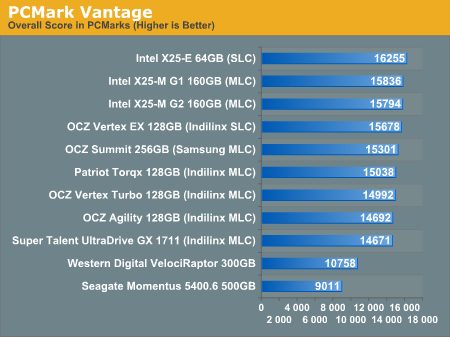
The overall PCMark Vantage score takes into account CPU and GPU performance and thus storage performance is only one aspect of determining your score. All of the SSDs do well here, the slowest configuration still around 36% faster than the WD VelociRaptor; something I'd say is more than reflected in real world performance.
The memories suite includes a test involving importing pictures into Windows Photo Gallery and editing them, a fairly benign task that easily falls into the category of being very influenced by disk performance.
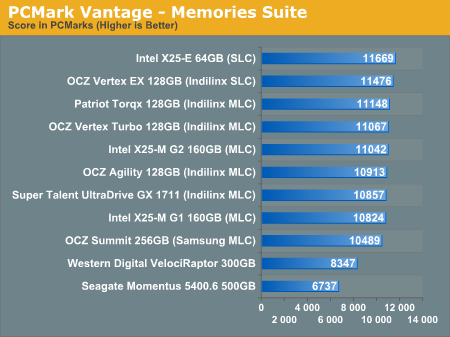
Once again the SSDs all perform very similarly here. The fastest of the group is Intel's X25-E, but the Indilinx drives actually hold the next three spots followed by the new G2. The performance range is very small between these drives though, you honestly can't go wrong with either an Indilinx MLC or X25-M.
The TV and Movies tests focus on on video transcoding which is mostly CPU bound, but one of the tests involves Windows Media Center which tends to be disk bound.
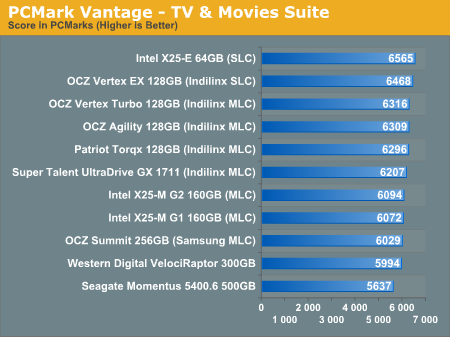
The standings continue to be roughly the same. We see just how much more competitive Indilinx is this time around than when the OCZ Vertex first hit the streets. We do have a real alternative to Intel.
The gaming tests are very well suited to SSDs since they spend a good portion of their time focusing on reading textures and loading level data. All of the SSDs dominate here, but as you'll see later on in my gaming tests the benefits of an SSD really vary depending on the game. Take these results as a best case scenario of what can happen, not the norm.
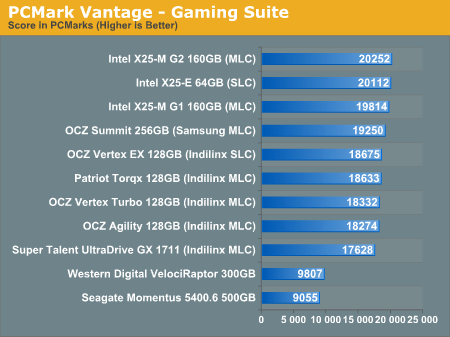
The Vantage Gaming Suite shows us our first example of the X25-M G2 pulling ahead of even the SLC X25-E. Even the Samsung based OCZ Summit does very well here.
In the Music suite the main test is a multitasking scenario: the test simulates surfing the web in IE7, transcoding an audio file and adding music to Windows Media Player (the most disk intensive portion of the test).
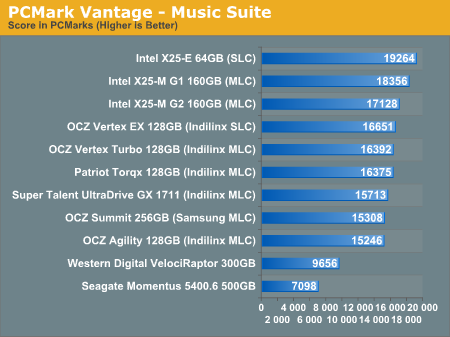
The Intel drives are at the top, the G1 faster than the G2, followed by the Indilinx drives, then the Samsung drive and the mechanical drives. New performance is important here because once TRIM shows up, this is closer to what you'll be seeing for a drive with a good amount of free space.
The Communications suite is made up of two tests, both involving light multitasking. The first test simulates data encryption/decryption while running message rules in Windows Mail. The second test simulates web surfing (including opening/closing tabs) in IE7, data decryption and running Windows Defender.
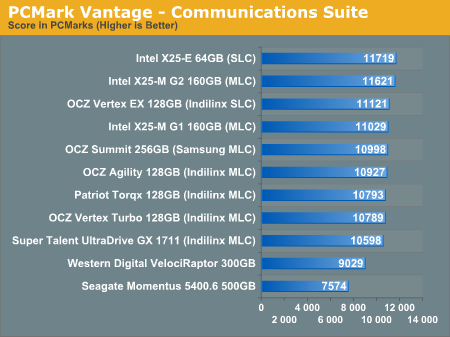
I love PCMark's Productivity test; in this test there are four tasks going on at once, searching through Windows contacts, searching through Windows Mail, browsing multiple webpages in IE7 and loading applications. This is as real world of a scenario as you get and it happens to be representative of one of the most frustrating HDD usage models - trying to do multiple things at once. There's nothing more annoying than trying to launch a simple application while you're doing other things in the background and have the load take seemingly forever.
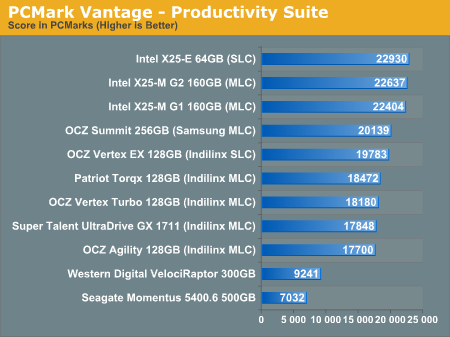
Here the Intel drives are at the top, by a noticeable margin. The G1, G2 and X25-E are all around the same level of performance. Samsung comes close with the OCZ Summit and the Indilinx drives pull up the rear. You can't go wrong with either the Intel or Indilinx drives but Intel is clearly faster here.
The final PCMark Vantage suite is HDD specific and this is where you'll see the biggest differences between the drives:
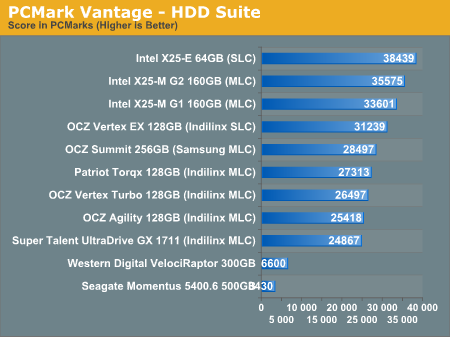
When it comes to pure drive performance, the breakdown doesn't get any simpler. Intel's X25-E holds the top spot, followed by the G2 and G1. While the G2 is only 5.6% faster than the G1, remember that we're looking at "new" performance here. Over time, with TRIM, the G2 will be closer to this performance, while the G1 will never get here again.
Despite poor random small file write performance, the OCZ Summit actually does very well here.
All of the drives perform incredibly compared to any mechanical hard drives.










295 Comments
View All Comments
tachi1247 - Friday, September 18, 2009 - link
Does anyone know what the difference is between the 7mm thick and 9.5mm thick drives?http://download.intel.com/design/flash/nand/mainst...">http://download.intel.com/design/flash/nand/mainst...
They seem to be identical except for the drive thickness.
dszc - Saturday, September 12, 2009 - link
FANTASTIC series of articles. Kudos! They go a long way toward satisfying my intellectual curiosity.But now it is time to reap the rewards of this technology and earn a living.
So I need some real-world HELP.
How do I clone my 320GB (80GB used) Hitachi OS drive (Vista 32 SP2) over to a 128GB Indilinx Torqx?
All I really care about is Photoshop and Bridge CS4 performance. I am a pro and work 4-16 hours per day in Bridge and Photoshop, with tens of thousands of images, including 500MB - 2GB layered TIFFs. The Photoshop Scratch Disk and Bridge and CameraRaw Cache performance are killing me. Solid State Storage seems to be the perfect solution to my problem
I really want to simply clone my 320 over to the Torqx, because it would take me a week to re-install and configure all of my software and settings that are now on the 320GB Hitachi.
Do I just bring the Torqx up in the Vista Storage Disk Management, initialize it with one big partition, and then format it?
What size allocation unit should I use? :
Default? 4096? 64k? ???
Will these settings be wiped out when I clone over the stuff from the old hard drive?
What about "alignment"?
What is the best software for a SIMPLE & painless clone procedure?
I'm not a techie or geek, but have a fair working knowledge of computers.
Any help would be hugely appreciated. Thanks.
userwhat - Thursday, September 17, 2009 - link
I use Drive Snapshot for all these purposes. It works 100%, it´s a very small and fast program. After having issues with Norton Ghost and some other similar programs which were absolutely unable to restore an imaged partition stored on a DVD this is THE one to use.Get it here: http://www.drivesnapshot.de/en/">http://www.drivesnapshot.de/en/
dszc - Saturday, September 26, 2009 - link
Thank you very much for your help and recommendations.To get my Patriot (SolidStateStorage) up and running, I used Seagate DiskWizard (an Acronis subset), as I have lots of Seagate drives already on my system and this free software seems to work.
When I get a window of time in my schedule, I'll try DriveSnapShot and/or DriveImage to see if they do a better job in helping my Torqx SSS run at its full potential.
Thanks again for your help.
Dave
JakFrost - Tuesday, September 15, 2009 - link
If you want to image out your current drive and migrate over to an SSD you can use the free software below that works with Windows Volume Shadow Copies to do a online live migration to another drive without losing or corrupting your data. This means that you can do this from the same OS that you are running.This software will allow you to image out to an already created partition that is already aligned at the 1MB boundry that is standard for Microsoft Vista/7 operating systems.
DriveImage XML V2.11
English (1.78MB)
Image and Backup logical Drives and Partitions
Price: Private Edition Free - Commercial Edition - Buy Now Go!
System Requirements: Pentium Processor - 256 MB RAM
Windows XP, 2003, Vista, or Windows 7
An alternative is to use an offline migration system such as Acronis TrueImage, Norton Ghost, etc. to do the migration offline from a bootable CD or USB drive. Search around for Hiren's BootCD to check out these and other tools to do the migration.
dszc - Saturday, September 26, 2009 - link
Thank you very much for your help and recommendations.To get my Patriot (SolidStateStorage) up and running, I used Seagate DiskWizard (an Acronis subset), as I have lots of Seagate drives already on my system and this free software seems to work.
When I get a window of time in my schedule, I'll try DriveImage and/or DriveSnapShot to see if they do a better job in helping my Torqx SSS run at its full potential.
Thanks again for your help.
Dave
jgehrcke - Friday, September 11, 2009 - link
Be careful when buying a Super Talent UltraDrive GX 128 GB with "XXXX" in serial number (unfortunately you cannot check this before ordering the drive). These drives are much slower than measured in the benchmark here and in other benchmarks.For more information and related links see
http://gehrcke.de/2009/09/performance-issue-with-n...">http://gehrcke.de/2009/09/performance-i...est-supe...
Kitohru - Thursday, September 10, 2009 - link
Does OS X Snow Leopard have trim support, and if not any word from apple about that or the like?Zool - Thursday, September 10, 2009 - link
I still dont think that with this price ssd-s will be more mainstream in the next years. And honestly the performance is not even that extra if everything would work like it should. The mechanical drives can reach now 100 MB reads when things are optimal. The small files performance is still only software problem. U should never ever reach point when u need to randomly find 4 KB files in a long row. With todays ram capacity and cpus-s programs should never read such small files or group things in larger files and read whole to memmory. A solid today programed aplication (let it be game or programs) should never let your disk spam with 30k files (like catia or other plenty of aged so called "profesional" programs). With today ram and disk capacity it should read things to memmory and let only grouped larger files on disk and never ever touch the hdd again until users isnt comunicating with the software (u can tell it to windows).Saves can be made to memmory and than write to disk without even seeing a fps drop in games(not just games) becouse of disk comunication latenciI dont even think the IO performance would be a problem with the RIGHT software and OS. With 100MB reads it could run perfectly fine with few seconds loading times. Even the latencies of ssd-s are no match to ram latencies so everithing that should activly comunicate with disks (which is just stupid with curent ram prices and 64bit) would just level your latencies down to disks.
Why should worry about latencies and read speeds when u could copy it to ram and keep the files on disk in shape where the mechanical drive
should never find itself to read files smaller than few MB.(even your
small txt documents u can hide in archive).
Just my toughs. (sorry for my english)
AlExAkE - Wednesday, September 9, 2009 - link
Hey, I'm a web & multimedia designer. I spend lots of my time using most of the Adobe CS4 products including Photoshop, Flash, Dreamweaver, Illustrator, After Effects & Premiere Pro.The Intel 80GB G2 looks amazing, but the Photoshop test is awful because of his write speed. The Intel 25-Extreme series seem to be the best but is to pricey. The OCZ Vertex has good write speed but is slower than Intel G2 in most of the test. What would be the recommended SSD for my purpose. Thanks